Tokamachi City Overview
The information on this page is a broad introduction to Tokamachi City that is current as of the time of posting. If you require further information, please contact us using the inquiry form. Inquiries related to tourism should be directed to the Tokamachi Tourist Association.
Tokamachi City Profile
Tokamachi City (十日町市)

(Tokamachi City Flag)
| Prefecture | Niigata Prefecture(新潟県) |
|---|---|
| Total Area | 590.39km2 (227.95mi2) |
| Population | 46,646 |
| Population Density | 91.6/km2(237/mi2) |
| Sister Cities | International
|
| Host Town | International
|
City Flower
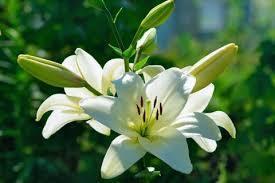
Lily (ユリ, yuri)
City Tree
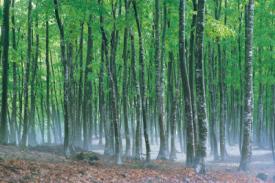
Japanese Beech (ブナ, buna)
City Emblem
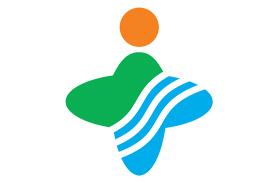
Tokamachi, when translated into English, becomes “Ten Day Town.” But why is this our city’s name? Since long ago, the city would host a market on the 10th of every month. During the town merger in 2005 (when suburbs Kawanishi, Matsudai, Matsunoyama, and Nakasato were officially absorbed), the name was reexamined but in the end remained the same due to its familiarity and desire to continue to expand and explore this new Tokamachi City.
The logo, designed to look like a person, is derived from the first kanji character in Tokamachi (十日町), or Ten. The head is orange, symbolizing the sun and the arms are outstretched in a warm embrace for anybody wishing to come here. The green and blue represent the blessings brought by the natural landscape and the Shinano River, whilst the white represents snow. This emblem is an expression of the hopes and dreams of a city which strives for development in harmony with its beautiful natural environment.
Where is Tokamachi City?
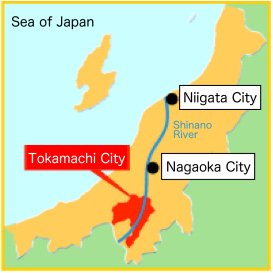
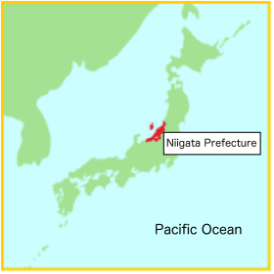
Tokamachi City is located in the southernmost region of Niigata Prefecture, near the Nagano prefectural border. The city is encompassed by Minami-Uonuma City to the east, Ojiya City to the north, Kashiwazaki City and Jōetsu City to the west, and Tsunan Town and Yuzawa Town to the south.
It is about 100 kilometers from the prefectural capital, Niigata City, and 200 kilometers from Tokyo. Using the JR Jōetsu Shinkansen (bullet train) and Hokuhoku Express local train it takes around 2 hours to travel between Tokyo and Tokamachi City.
Landscape and Climate
Landscape
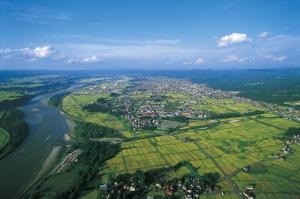
An aerial view of the Shinano River and central Tokamachi
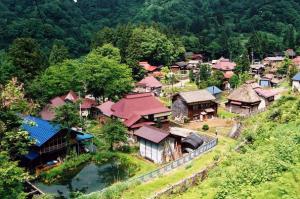
The Koshirakura settlement
Tokamachi City has a diverse natural landscape consisting of mountains, valleys, rivers and forests. The Shinano River, Japan’s longest, flows northward through the central region in between grand, staircase-like river terraces that have taken shape on its banks. The city’s population is distributed throughout a vast region composed of both urban areas and agricultural settlements. In the western region of Tokamachi City, inside the basin area of the Shibumi River, the rice terraces and hamlets of agricultural communities are part of beautiful rural landscape.
The Uonuma Hills and Higashikubiki Hills mountain ranges mark the east and west borders of Tokamachi City respectively. Also, the mountains that cover the southernmost region that reach altitudes of 2,000 meters and extend southwards into the Jōshin’etsu-kōgen National Park area.
Climate

Locals work to clear the snow from a house.
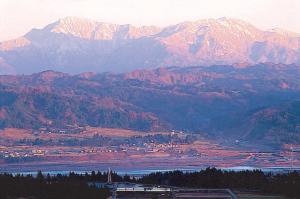
A view of the Echigo Mountains as seen from Tokamachi City.
The region's climate is characterized by its close proximity to the Sea of Japan, and is blessed with an abundance of seasonal character and change throughout the year. During the winter season, snowfall accumulates to between two to three meters in the Tokamachi downtown area, and as deep as 5 meters in the mountain areas. Tokamachi City is officially registered as a heavy snowfall region.
Nature and Art Tourism
Echigo-Tsumari Art Triennale
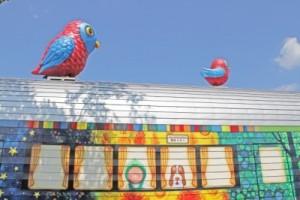
Bringing colour, imagination, and millions of visitors to the region, the “Echigo Tsumari Art Triennale” is an event like no other. With artworks dotted throughout a region roughly equal the size of Greater Tokyo, it is the world’s largest outdoor contemporary art festival, and boasts collaboration from both local artists and world renowned artists such as James Turrell and Yayoi Kusama. Even for the visitor with no particular interest in contemporary art, travelling across Echigo-Tsumari (the old name for today’s Tokamachi City and Tsunan Town) is a one-of-a-kind opportunity to discover the culture, lifestyles, landscape and foods of the Japanese countryside. Although the main festival is only held triennially, many of the artworks and events are accessible the following years as well. For more information, please see the event homepage.
Echigo Tsumari Art Triennale Official Homepage
Nature Tourism
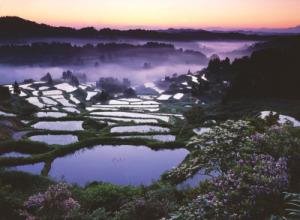
Tokamachi City’s natural landscape is geographically diverse and nearly untouched by the human hand. Unique scenic sites such as the Hoshitoge Rice Terraces (pictured); the Bijinbayashi Forest, or “the Forest of Beauties”; and the Kiyotsu Gorge, counted as “1 of Japan’s 3 Most Beautiful Gorges and Valleys”, all attract great numbers of photographers and tourists year round. There are also numerous onsen located throughout the region, including Matsunoyama Onsen which is counted as “1 of Japan’s Top 3 Medicinal Onsen”.
Winter Tourism

Tokamachi City is part of the Snow Country Tourism Zone, and there are many events in the winter season which make use of the region’s heavy snowfall. The main event is the Tokamachi Snow Festival which features snow sculptures made only of snow and by hand of the residents of Tokamachi. A ton of delicious, hearty cuisine can be tried at this festival, you can enjoy playing in the snow , riding a sleigh, and admire the fireworks in the night! Other events include the Echigo Matsudai Fuyu-no-jin, and the Nakasato Snow Carnival. There are also many ski slopes throughout Tokamachi City and in the neighboring regions.
Industry and Specialty Products
Kimono
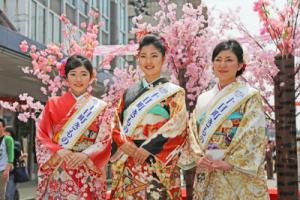
In Tokamachi, where for around half of the year heavy snowfall puts a halt to agriculture, textile manufacture has always been a prominent industry; the earliest evidence of this are weaving tools dating back to the ancient Kofun period that were discovered in the region. In the contemporary period, textile manufacture progressed from hemp to silk-based textiles during the Edo period, before the development of dyeing practices in the Showa period. Weavers in Tokamachi continued to make improvements to production techniques, creating kimono fabrics such as Tokamachi Gasuri and Tokamachi Akashi-chijimi, which helped the region to gain the name of “Town of Kimono.” Today, Tokamachi celebrates this unique culture at the annual Tokamachi Kimono Festival where hundreds of locals dress in kimono and populate the downtown area. Every years is held the "gathering of the twenty-year-old people". The youngers celebrate by dressing up with long sleeved kimono "furisode" and long pleated trousers "hakama".
Uonuma Koshihikari Rice
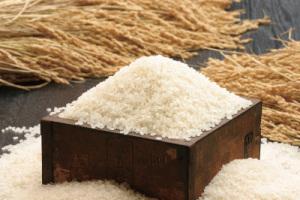
Known nationally as the best quality rice in Japan, “Uonuma Koshihikari” brand rice is grown here in Tokamachi City. The snow-melt water, and the hot and cold temperature ranges in the Tokamachi basin area provide the perfect conditions for rice cultivation. Uonuma Koshihikari rice can be enjoyed at a number of restaurants and eateries throughout the region. Or alternatively, you can pick up a bag for yourself to take home as a souvenir.
Hegi Soba
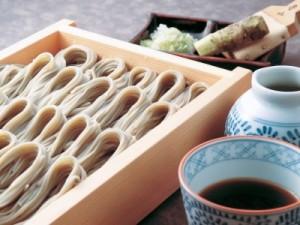
A local specialty in Tokamachi, these soba noodles are served in a wooden tray known as a “hegi”. They are made using funori, a type of seaweed which was traditionally used in textile manufacture. The funori creates a slightly bouncy and firm texture soba noodle, distinguishing hegi soba from other variations of soba noodle. They are served in bite-sized coils which are said to symbolize both waves crashing onto the shore and coils of cloth. Hegi soba can be enjoyed at a number of specialist shops in Tokamachi City.
National Treasure
Flame-style Pottery (kaen 'gata doki)
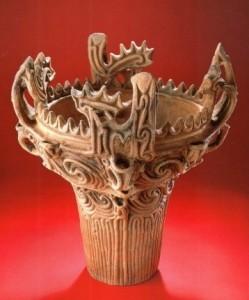
Flame-style Pottery Number 1
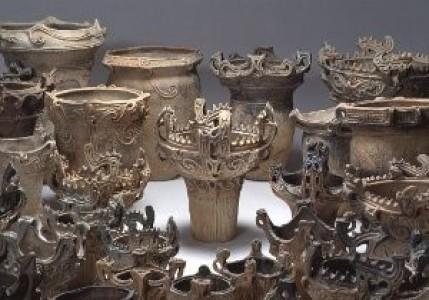
A collection of some of the flame-style and crown-type pottery vessels unearthed in Tokamachi City
The only Jomon period pottery from Niigata designated a National Treasure, the flame-style pottery was named after their design features that resemble burning flames. They were made during Middle Jomon, and used by the Jomon people to boil and cook food. This National Treasure symbolises ancient Japan, and has been highly evaluated internationally as the origin of Japanese art. Excavated in Tokamachi City, the Flame-style Pottery is availible for viewing at the Tokamachi City Museum (please check exhibition dates before visiting). Note: Middle Jomon: 3500-2500 BC For more information, please see the Tokamachi City Museum website.
Contact Us
General Affairs Department, Policy Planning Division, Public Relations Section
Address: 3 Chome-3 Chitosecho, Tokamachi-shi, Niigata-ken 948-0067 (2nd floor of the central government office)
Phone number: +81-25-757-3112
Facsimile number: 025-752-4635
You can contact them through mail here


Last updated:April 15, 2025